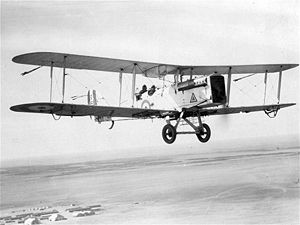Airco D.H.9A
| Airco D.H.9A | |
|---|---|

| |
| Role | Bomber/Reconnaissance |
| Manufacturer | Airco |
| Introduction | Aug 1918 [1] |
| Primary user | |
| Number built | 885[note 1] |
| Developed from | Airco D.H.9 |
| Wingspan | 14.0 m (45 ft 11 in) [3][4] |
| Engine | 400hp Liberty V12 |
| Armament | sync. fixed Vickers MG and 1-2 rear flexible Lewis MG 210–300 kg (460–660 lb)[4] of bombs |
| Ammo | 750 (Vickers) + 7 drums of 97 rounds (Lewis)[5] |
| Crew | 2 |
| Max Speed | 198 km/h (123 mph) [6][7][3][4] |
| Climb | 2,000 m (6,500 ft) in 8:55 3,000 m (10,000 ft) in 15:45 5,000 m (16,500 ft) in 43:50 [6][3] |
| Service Ceiling | 5,100 m (16,750 ft)[6][7][3] |
| Absolute Ceiling | 5,500 m (18,000 ft)[6][4] |
| Endurance | 5:15 [6][7][4] |
What a difference an engine makes! The Airco D.H.9 had always struggled to perform its mission with a barely-adequate 230 Siddeley Puma engine. Replacing that with a 400hp Liberty V12 turned the Airco DH9a "Nine-Ack" into a winner, albeit one that only had impact in the last few months of the war. Liberty engines were delivered in much smaller numbers than projected, and though the first eighteen machines were delivered in June 1918, it was not until the end of August that the first squadron in France began combat missions. Though only a handful of squadrons received their DH9As before the armistice, the type served on for many years afterwards in a variety of roles.[8]
For more information, see Wikipedia:Airco DH.9A.
Timeline [note 2]

Game Data
Wings of Glory
| Version | Availability | Maneuver | Damage | Dmg Points | Max Alt. | Climb |
|---|---|---|---|---|---|---|
| Twin Lewis | 18Q3-18Q4 | B | B/A | 17 | 11 | 6 |
| Single Lewis | B | B/B | 17 | 11 | 6 |
Plane and Crew Cards
-
99 Sqn
Unknown
OldGuy59
Blue Max/Canvas Eagles
Miniatures and Models
1:100 Scale
- Shapeways:
- Single-Lewis: Reduced Aircraft Factory
- Twin-Lewis: Reduced Aircraft Factory
1:144 Scale
- Shapeways:
- Single-Lewis: Reduced Aircraft Factory
- Twin-Lewis: Decapod, Reduced Aircraft Factory
1:285/6mm/1:288 Scale
- Shapeways: Reduced Aircraft Factory
- Cast Metal: MSD Games/Hostile Aircraft
1:600 Scale
- Shapeways: Reduced Aircraft Factory
1:700 Scale
- Shapeways: Reduced Aircraft Factory
Resources
Orthographic Drawings
References
- Notes
- Citations
- Bibliography
- Enzo Angelucci, ed. The Rand McNally Encyclopedia of Military Aircraft, 1914-1980. New York: The Military Press, 1983 edition. ISBN 0-517-41021-4.
- J.M. Bruce. British Aeroplanes 1914-18. Great Britain: Funk & Wagnalls, 1957, 1969. ISBN 0370000382
- Kevin Kelly, "Belts and Drums: A Survey of First World War Aircraft Ammunition Totals". Over the Front, Vol. 5, No. 3, Autumn 1990. Walsworth Publishing Co, Inc. and The League of World War I Aviation Historians.
- W.M. Lamberton and E.F. Cheesman, Reconnaissance & Bomber Aircraft of the 1914-1918 War. Great Britain: Harleyford Publications Ltd., 1962. ISBN 9780900435027
- Kenneth Munson, Bombers: Patrol and Reconnaissance Aircraft, 1914-1919. New York: The MacMillan Company, 1968, Blandford Press Ltd. ISBN 978-0753721711
- Colin Owers, Great War Aircraft in Profile 6: De Havilland Aircraft of World War I; Volume 2: D.H.5 - D.H.15. Boulder, Colorado: Flying Machines Press, 2001. ISBN 1-891268-18-X
- Ian Philpott, The Birth of the Royal Air Force. Great Britain: Pen & Sword Books Limited, 2013. ISBN 978-1-78159-333-2

